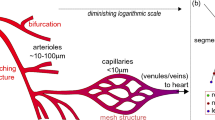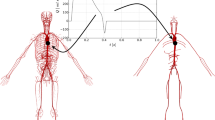Abstract
Branching patterns of arterial networks might influence vascular resistance and allow control of blood supply to peripheral tissues. Arterial casts from the brain, kidneys, and earlobes of cats and the chorioallantoic arteries of chick embryos were used for microscopic measurements of arterial geometry. From the measured diameters of parent and two daughter vessels at arterial bifurcations, we calculated the diameter exponent m. By applying the minimum work concept to blood flow through a cylindrical vessel, an optimal value m = 3 has been derived (Murray’s cubic law). The measured values of the diameter exponent were 2.59, 2.54, 2.58, and 2.49 for the brain, kidneys, earlobes, and chick embryos, respectively, exhibiting significant deviation from Murray’s law. The physiological implication of the m values is discussed here.







Similar content being viewed by others
References
Murray CD (1926) The physiological principle of minimum work I. Proc Natl Acad Sci 12:207–214
Murray CD (1926) The physiological principle of minimum work applied to the angle of branching of arteries. J Gen Physiol 9:835–841
Zamir M (1978) Nonsymmetrical bifurcations in arterial branching. J Gen Physiol 72:837–845
Zamir M, Medeiros A, Cunningham K (1979) Arterial bifurcation in the human retina. J Gen Physiol 74:537–548
Suwa N (1963) Estimation of intravascular blood pressure gradient by mathematical analysis of arterial casts. Tohoku J Exp Med 79:168–198
Matsuo T, Okeda R et al (1989) Morphometry of arterial bifurcations of the pial arterial tree of the cat brain. FORMA 4:123–133
Taber L, Ng S, Alicia M et al (2001) Investigating Murray’s law in the chick embryo. J. Biomech 34:121–124
LaBarbela L (1990) Principles of design of fluid transport systems in zoology. Science 249:992–1000
Bennett S, Eldridge M, Zaghi D et al (2000) Form and functions of fetal and neonatal pulmonary arterial bifurcations. Am J Physiol 279:H3047–H3057
Cassot F, Lauwers F, Lorthois S et al (2009) Scaling laws for branching vessels of human cerebral cortex. Microcirculation 16:331–346
Cassot F, Lauwers F, Lorthois S et al (2010) Branching patterns for arterioles and venules of the human cerebral cortex. Brain Res 1313:62–78
Author information
Authors and Affiliations
Corresponding author
About this article
Cite this article
Matsuo, T., Watanabe, Si., Nakakubo, M. et al. Form and function of arterial bifurcations in various parts of the animal body. Artif Life Robotics 18, 2–6 (2013). https://doi.org/10.1007/s10015-013-0091-3
Received:
Accepted:
Published:
Issue Date:
DOI: https://doi.org/10.1007/s10015-013-0091-3




